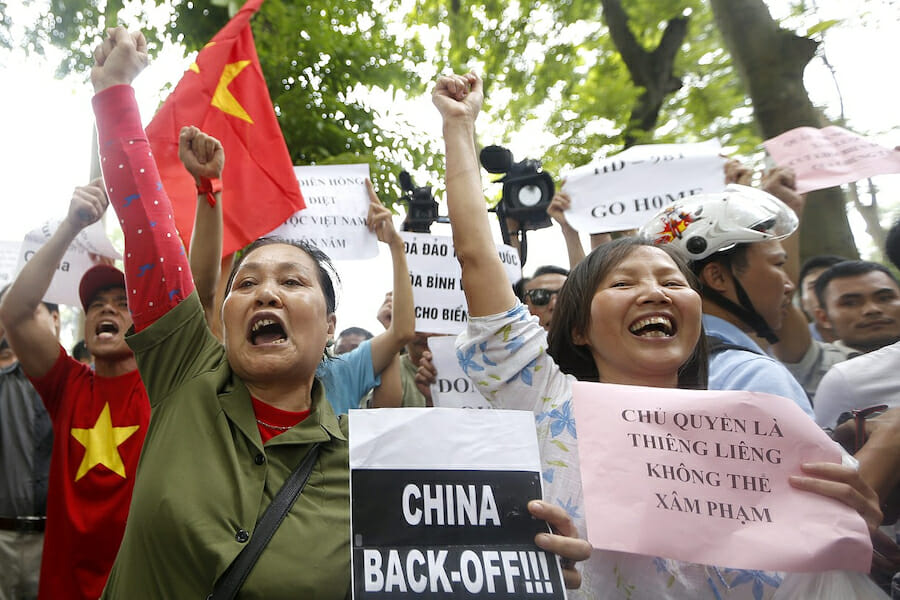
Beijing Stumbles in Vietnam
Beijing’s clumsy efforts at foreign policy seem to have backfired again, as its deployment of a deep-sea oil drilling rig in disputed waters off Vietnam triggered widespread protests and rioting in Vietnam this past week. In possibly the worst breakdown in ties between the two Communist neighbors since a brief border war in 1979, worker protests broke out in 22 of the country’s 63 provinces, targeting Chinese-owned factories and Chinese nationals.
Over 400 factories were damaged, including some 200 Taiwanese, 55 South Korean, and 10 Japanese factories. Xinhua, the Chinese state news agency, reported the death of two Chinese nationals and over 100 injured as a result of the rioting. Chinese expatriates filled the airports waiting for flights out of the country, while some 600 Chinese nationals crossed into Cambodia over the land border. Vietnamese authorities have arrested over 1000 people involved in the rioting and issued text messages nationwide to quell the unrest.
Anger at China had been building after the Chinese floated a $1 billion deep-sea drilling rig to disputed waters close to the Paracel Islands on May 1. The Paracels are known as the Xisha to the Chinese and the Hoang Sa to the Vietnamese. While Vietnam lays claim to the more than 30 islets, sandbanks and reefs as part of its 200-mile exclusive economic zone, the islands are currently controlled by China’s Hainan Province, which in July 2012 established Sansha City to administer the three townships under its jurisdiction. China took control of the islands in 1974 in a naval skirmish between China and Vietnam following the withdrawal of American troops.
This latest skirmish in the South China Seas comes as China takes an increasingly assertive stance regarding its claim of virtually 90 percent of the entire South China Sea, parts of which are also claimed by Brunei, Malaysia, the Philippines, Taiwan and Vietnam under their own 200-mile exclusive economic zones.
Many analysts believe China is embarking on a strategy of gradually pressing its claims to the disputed waters by small, incremental actions taken on the fleets of other countries, such as cutting cables to their exploration vessels, imposing fishing bans and harassing their fishermen. Beijing’s latest action appears to be yet another test of the military prowess of its neighbors, intended to be a bold and provocative action that falls just short of drawing a military response.
In responding to Beijing’s latest challenge over the South China Seas, Hanoi, therefore, has few options available. Hanoi’s official diplomatic protests to Beijing have so far had little effect, yet allowing more protests domestically could backfire, with potential foreign investment scared off just when Vietnam’s struggling economy needs it the most. Aside from diplomatic protests, Vietnam could make its own resource grab in the disputed waters, encouraging fishing boats to ply the area and deploying patrols from its newly established Fisheries Resources Surveillance force to protect its fishermen and assert its sovereignty and jurisdiction over the area. But this course of action will only lead to more minor, and possibly major, skirmishes, and more martyred fishermen.
Last weekend’s Association of Southeast Asian Nations meeting was an opportunity for Vietnam, and other South Sea claimants, to press their calls for an early conclusion to talks over a code of conduct to govern the disputed South China Sea. Yet China hesitates to sign a multilateral code of conduct, preferring instead to negotiate with each member on a bilateral basis, despite being party to an earlier, and unenforceable, declaration of conduct.
Hanoi’s only remaining peaceful option is to pursue international arbitration, much like the Philippines has taken its territorial dispute with China to the Permanent Court of Arbitration in The Hague. Vietnam’s lawsuit would likely draw on a key clause of the 1982 United Nations Convention on the Law of the Sea (UNCLOS), which states “Coastal States have sovereign rights in a 200-nautical mile exclusive economic zone (EEZ) with respect to natural resources and certain economic activities.” Despite China having ratified the Law of the Sea in 1996, the Chinese government made a further declaration in 2006 stating it did not accept any of the procedures provided for with respect to disputes. Even with a ruling in hand, UNCLOS does not provide for any enforcement mechanism for decisions handed down either by the International Tribunal on Law of the Sea (ITLOS) or by an arbitral tribunal.
Hanoi’s other option is to file a petition with the United Nations Security Council, but the Council can only act if none of the five permanent members oppose a resolution, and China, as one of the five permanent members, would surely veto it. While a ruling from an international court may not immediately be forthcoming, or eventually enforceable, Hanoi should at least present its evidence and take the necessary steps to win a victory in the courts of international opinion.
